
Browse an alphabetical list of photographs. These historical images portray people, places, and events before, during, and after World War II and the Holocaust.
<< Previous | Displaying results 26-50 of 2641 for "Photo" | Next >>
Aron was born to a middle-class Jewish family in Slonim, a part of Poland between the two world wars. His parents owned a clothing store. After studying in a technical school, Aron worked as a motion-picture projectionist in a small town near Slonim. The Soviet army took over Slonim in September 1939. War broke out between Germany and the Soviet Union in June 1941. Aron returned to Slonim. The Germans soon occupied Slonim, and later forced the Jews into a ghetto.
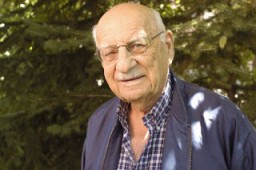
This 2005 Syrian edition of the Protocols of the Elders of Zion claims that the terrorist attacks of September 11, 2001, were orchestrated by a Zionist conspiracy. The final chapter predicts the eventual destruction of the State of Israel. Published in Damascus, Syria, 2005. Gift of the Embassy of Israel.
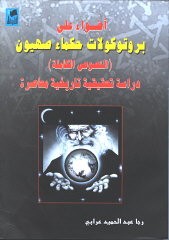
US soldiers of the 8th Infantry Regiment seek cover behind hedges and signs to return fire to German forces holding the town of Libin. Belgium, September 7, 1944.
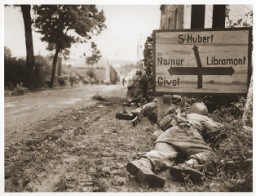
In Hamburg, members of the SA and students from the University of Hamburg burn books they regard as "un-German." Hamburg, Germany, May 15, 1933.
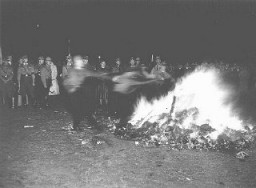
At the Neu Freimann displaced persons camp, a boy displays the tattooed number on his arm to a photographer. Other children look on. Neu Freimann, Munich, Germany, between 1945 and 1949.
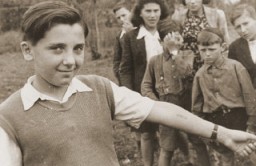
A British soldier removes refugees, wounded resisting the British, from the ship Exodus 1947. Haifa, Palestine, July 20, 1947.
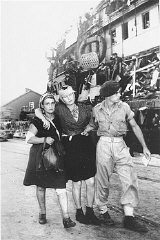
A British soldier watches women SS guards who were forced to carry victims' corpses to mass graves. Bergen-Belsen, Germany, after April 15, 1945.
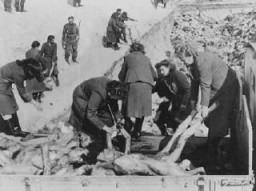
A building burns during the suppression of the Warsaw ghetto uprising. The photograph was taken through the window of a building adjacent to the ghetto. Warsaw, Poland, May 1943.

Entrance to the courtyard, marked with a Star of David, of a building designated for Jews. Budapest, Hungary, after April 2, 1944.
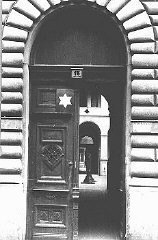
Amon Goeth (front left), commandant of the Plaszow camp, under escort to the courthouse in Kraków for sentencing. He was sentenced to death at his postwar trial on war crimes charges. Kraków, Poland, August 1946.
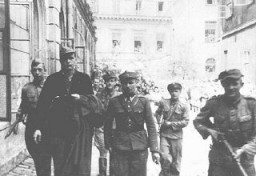
A captured Jewish resistance fighter who was forced out of his hidden bunker by German soldiers during the Warsaw ghetto uprising. Warsaw, Poland, April 19-May 16, 1943.
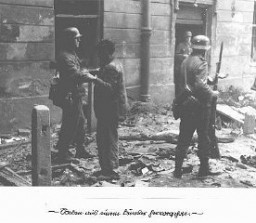
A ceremony of the pro-Nazi German American Bund. Kenosha, Wisconsin, United States, October 16, 1937.
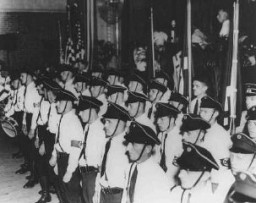
A chaplain with the 82nd Airborne Division helps a survivor board a truck that will evacuate him from the Wöbbelin concentration camp to an American field hospital. Germany, May 4, 1945.
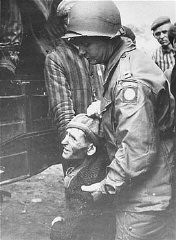
A child survivor arrives at Haifa port on board the Aliyah Bet ("illegal" immigration) ship Mataroa. The British denied the passengers entry into Palestine and deported them to Cyprus detention camps. July 15, 1945.
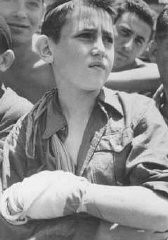
Soon after liberation, an emaciated child survivor is carried out of camp barracks by Soviet first-aid workers. Auschwitz, Poland, after January 27, 1945. This photograph is a still image from Soviet film of the liberation of Auschwitz.
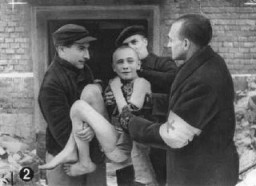
A young child sits among luggage while waiting to depart the Deggendorf displaced persons camp. Deggendorf, Germany, 1945-46.
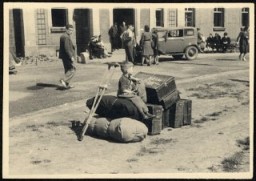
A child wears the compulsory Jewish badge. The "Z" stands for the word "Jew" (Zidov) in Croatian. Yugoslavia, ca. 1941.
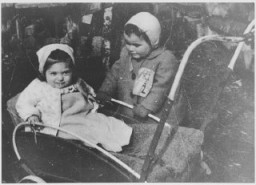
A class of boys from the school in Oradour. All of the people pictured here were killed by the SS during the June 10, 1944, massacre. Oradour-sur-Glane, France, photograph taken between 1940 and June 1944.
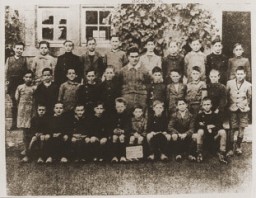
First grade pupils, both Jewish and non-Jewish, study in a classroom in a public school in Hamburg. Germany, June 1933.
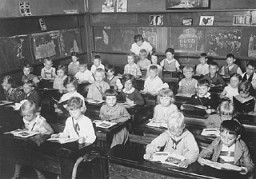
American Legion officials touring Germany and Austria pass through the Dora-Mittelbau concentration camp, near Nordhausen. Germany, after June 6, 1945.
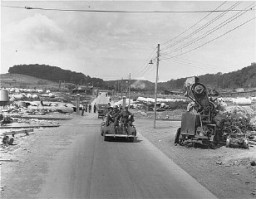
A concert in the Oranienburger Street synagogue organized by the Cultural Society of German Jews. Berlin, Germany, 1938.
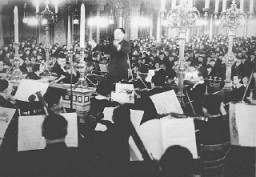
A couple dances at the Eldorado, a nightclub frequented by members of Berlin's gay and lesbian community. The nightclub, along with other similar establishments, was closed by the Nazi government in the spring of 1933. Photograph taken in Berlin, Germany, 1929. Learn more about the Eldorado.
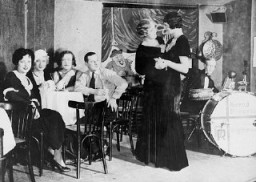
A cheering crowd greets Adolf Hitler as he enters Vienna. Austria, March 1938. After a prolonged period of economic stagnation, political dictatorship, and intense Nazi propaganda inside Austria, German troops entered the country on March 12, 1938. They received the enthusiastic support of most of the population. Austria was incorporated into Germany the next day.
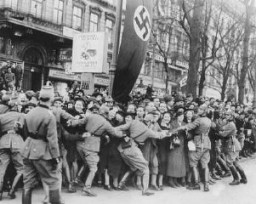
A crowd in front of the Berlin Cathedral (Berliner Dom) cheers the declaration of World War I. Berlin, Germany, August 1914. Many enthusiastically believed that World War I would be over quickly. Instead, the war became a stalemate of costly battles and trench warfare. It lasted for years and was the first great international conflict of the twentieth century. The impact of the conflict and its divisive peace would reverberate in the decades following.
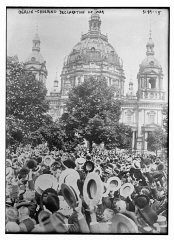
A large crowd gathers in front of the Rathaus to hear the exhortations of Julius Streicher during the Beer Hall Putsch, Hitler's early unsuccessful attempt to seize power. Munich, Germany, November 1923.
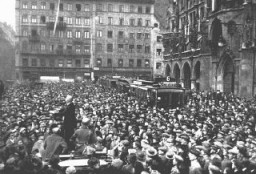
We would like to thank Crown Family Philanthropies, Abe and Ida Cooper Foundation, the Claims Conference, EVZ, and BMF for supporting the ongoing work to create content and resources for the Holocaust Encyclopedia. View the list of donor acknowledgement.